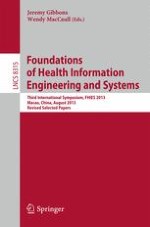2014 | Book
Foundations of Health Information Engineering and Systems
Third International Symposium, FHIES 2013, Macau, China, August 21-23, 2013. Revised Selected Papers
Editors: Jeremy Gibbons, Wendy MacCaull
Publisher: Springer Berlin Heidelberg
Book Series : Lecture Notes in Computer Science
